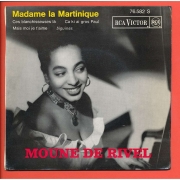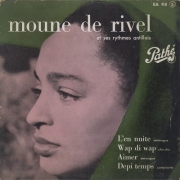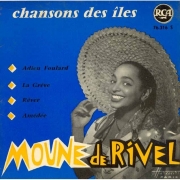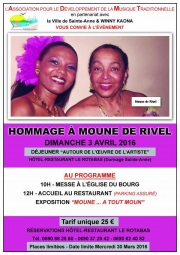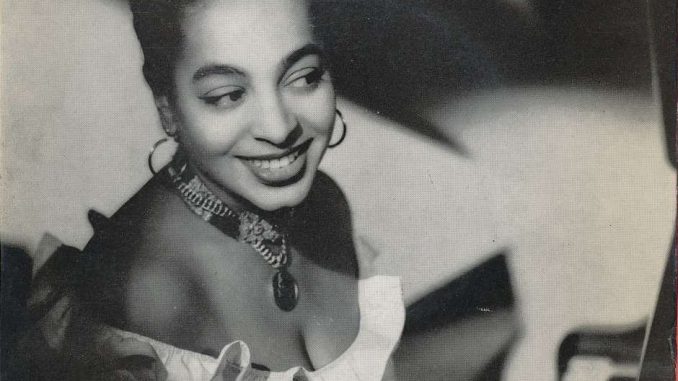
On April 2016, the Association for the Development of Traditional Music and the town of Sainte-Anne in Guadeloupe paid tribute to Moune de Rivel. On the programme of this day, there were a religious mass to her memory, an exposure that was titled “Moune…A Tout Moun” and a lunch to talk about her works.
Last year, on March 27, 2015, one year to the day after the death of Moune de Rivel, the singer Winny Kaona who thinks that she is her spiritual daughter, organized in her memory two shows at the Salle George Tarer in Pointe-à-Pitre. Several artists such as Émile Antile, Roland Louis, Guy Jacquet and Yves Honoré and cultural associations (Kaloukéra, K’Danse, Les Ténors de la Guadeloupe and Flè a Bamboo) took part in this musical cabaret. An “Anthology of Biguine”, dedicated to the forerunners of this music that was born during the interwar period, was presented in the first part of the show.
Kariculture.net presents Moune de Rivel’s career, this great lady of the Caribbean culture.
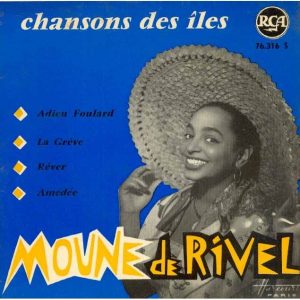
Nobody has forgotten Moune de Rivel. The real name of this musician, singer, actress and painter who was born in Bordeaux (France) in 1918, is Cécile Jean-Louis. Her parents are Guadeloupeans. Her father, Henri Jean-Louis Baghio’o, is from St. Anne and magistrate ; her mother, Fernande de Virel, is from Pointe-à-Pitre and she is the Count de Virel’s daughter, a Breton arrived in Guadeloupe during slavery. Moune de Rivel’s grandfather taught white settlers’ children music but when he agreed to teach also freed slaves’ children, his white students left the classroom definitely… Moune Rivel’s mother is also a great musician with her 1st violin prize and her 2nd piano prize of the Paris Conservatory of Music (Conservatoire National de Paris). Because of her father’s profession, little Cécile travels a lot in Martinique, in Africa before settling down in France. The six-year-old girl meets at home many Caribbean artists who live in Paris among them Stellio and Leona Gabriel. Because she is very interested in Creole music, her mother write for her two songs : “Manmzelle ka ou tini ?” and “Chocolat a la doumite”.
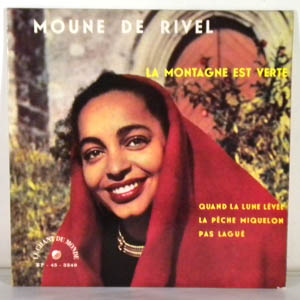
Cécile becomes Moune
When she is 16 years, Cécile appears live, for the first time, at Le Cabaret de la Boule Blanche at Montparnasse in Paris accompanied by her mother on the piano. She chooses Moune de Rivel as stage name by reversing her mother’s surname.
Then, Moune de Rivel performs for several years at La Canne à Sucre, the famous Parisian cabaret which is the “temple of Caribbean music” particularly biguine and in theatres of the French capital.
From 1946 to 1948, she performs in another great room in New York, The Café Society. The famous American magazine Life devoted an article to her in its issue of April 1st, 1946. The same year, she marries Ellis Larkins, an American jazz pianist then she gets divorced in 1949.
In 1961, she launchs two radio programs on Office de Radiodiffusion Television Française (ORTF) called “Charmes de Paris” and “Sources Vives”. Moune de Rivel is still very attached to the West Indies and, from 1963, she presents several folklore shows (including “Evocation des Antilles”, “Antilles d’Hier et d’Aujourd’hui) in various Parisian venues as La Comédie Française, Le Theâtre de l’Alliance Française, Le Théâtre Recamier and Le Vieux Colombier.
In 1970, her show “Paris-Antilles” is scheduled in the famous Bobino. In 1972, Moune de Rivel is on stage at the Casino de Deauville. Tireless and passionate, the artist presents, then, in Le Parc de Vincennes,“Le Festival Caraïbes” and, in 1974 , her new show, “Horizons Creoles” at Carré Thorigny.
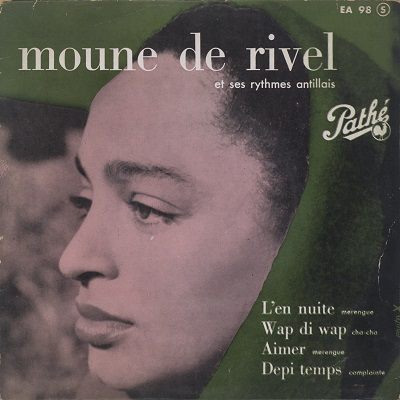
A generous artist
Moune de Rivel also frequents Pathé-Marconi studios, RCA, Thomson Ducretet, Chant du Monde to record discs and to sing with the greatest Caribbean musicians of the moment (Al Lirvat, Barel Coppet, Pierre Louiss etc.). She even has a fan club with 300 members in Finland, a country where she plays, sings and dances for about 40 years.
Moune de Rivel also becomes an actress and acts in movies and TV films such as : “Aux Yeux du Souvenir” by Jean Delannoy (1948), “Trois Femmes” by André Miche (1952), “Meurtre en Sourdine” by Gilbert Pineau (1967), “L’Écume des Jours” by Charles Belmont (1968), “Popsy Pop” by Jean Herman (1971) with Claudia Cardinale, “L’Atlantide” by Jean Kerchbron (1972), “Paul et Virginie” by Pierre Gaspart-Huit (1974)…
Moune de Rivel, the generous, does not forget to help young artists who land in Paris, from Guadeloupe, Martinique, Guiana and Reunion. She creates a small school to teach them her art, in addition to her family responsabilities ; she has five children, four of them were adopted.
She received several awards from Guadeloupe, France and Upper Volta (now, Burkina Faso).
Moune de Rivel, this famous Caribbean lady, remains after her death in 2014, the star that twinkles on the art scene.

